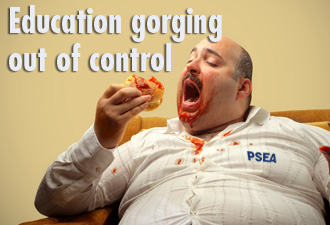Commentary

The True Beneficiaries of Education Subsidies
Gov. Rendell’s budget once again demands significant increases in public school spending. Ostensibly, these increases are “for the children,” but a close examination of education spending and policy proposals reveals Gov. Rendell’s priority – appeasing education’s special interests.
While voters support more spending on education, they dramatically underestimate what we spend now. Surveys show that voters believe public schools spend $4,000 per student, although the true cost is more than triple this amount. Today, Pennsylvania school districts spend over $13,000 per student on average (that’s $325,000 for a class of 25 students)-a 125% inflation-adjusted increase since 1980.
Yet academic performance has not improved at the same pace. SAT scores remain stagnant. Our analysis shows no correlation between per-pupil expenditures and PSSA scores by Pennsylvania school districts, a finding mirrored in a recent study from the Math and Science Partnership of Greater Philadelphia. And performance on the NAEP test shows little improvement-more than half of Pennsylvania fourth- and eighth-grade students are not proficient in reading or math. Public education spending has benefited some students, but that more dollars is a panacea to improving academic performance should be questioned.
What isn’t questionable is that the education industrial complex-including union bosses, school boards, and school construction contractors-drives education spending higher every year. While Pennsylvania public school enrollment declined by 27,000 students over the past 10 years, the number of public school employees increased by 33,000. Most of these new employees pay dues to the PSEA labor union, which, coincidently, runs one of the largest political action committees in the state and heavily funded Gov. Rendell’s campaigns.
The fastest growing area of school district spending is construction and debt spending, which has doubled in just 10 years. If Gov. Rendell truly cared about the children, he would support repealing the prevailing wage law for school districts, as Sen. Mike Brubaker has proposed. This law increases the cost of construction by 20% or more. Repealing this costly mandate could send $400 million back into the classroom.
Furthermore, if Gov. Rendell truly prioritized children, he would expand Pennsylvania’s school choice options-including charter schools, cyber schools, and the Educational Improvement Tax Credit (EITC), which have long waiting lists. These alternatives cost taxpayers less than traditional public schools: $2,000 per pupil less in charter schools, $4,000 for cyber charter schools, and $12,000 less for the average EITC scholarship. Instead, Gov. Rendell supports a plan to slash the EITC again this year, though proposed increase in school district funding for this year is four times the entire EITC.
Rather than demand more taxpayer money to solve our educational challenges, Pennsylvania needs political leaders to prioritize spending, remove costly mandates, and give parents more control over their children’s education.
# # #
This commentary first appeared in the Allentown Morning Call on June 20.
Nathan A. Benefield is Director of Policy Research with the Commonwealth Foundation (www.CommonwealthFoundation.org), an independent, nonprofit public policy research and educational institute based in Harrisburg.